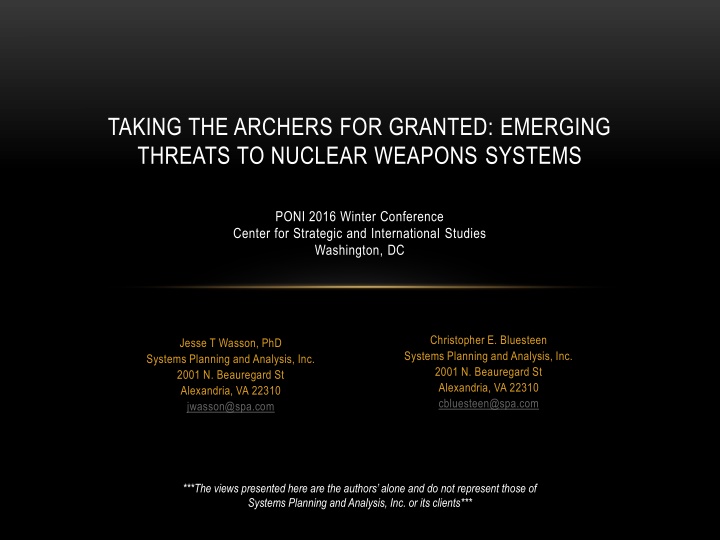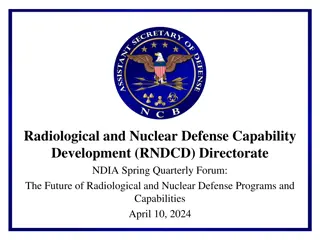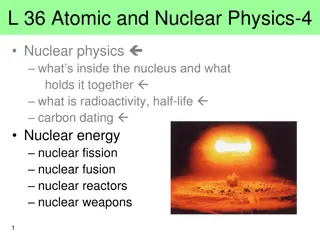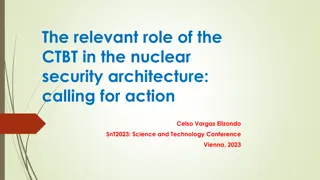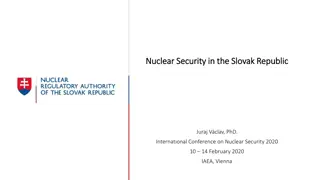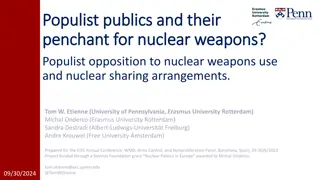Emerging Threats to Nuclear Weapons Systems
The discussion delves into the potential risks associated with nuclear weapons systems, focusing on the vulnerability of delivery systems to cyber threats. It raises concerns about the reliance on complex technology, commercial components, and cybersecurity issues within the U.S. defense systems, emphasizing the need for a sustainable long-term strategy.
Download Presentation

Please find below an Image/Link to download the presentation.
The content on the website is provided AS IS for your information and personal use only. It may not be sold, licensed, or shared on other websites without obtaining consent from the author.If you encounter any issues during the download, it is possible that the publisher has removed the file from their server.
You are allowed to download the files provided on this website for personal or commercial use, subject to the condition that they are used lawfully. All files are the property of their respective owners.
The content on the website is provided AS IS for your information and personal use only. It may not be sold, licensed, or shared on other websites without obtaining consent from the author.
E N D
Presentation Transcript
TAKING THE ARCHERS FOR GRANTED: EMERGING THREATS TO NUCLEAR WEAPONS SYSTEMS PONI 2016 Winter Conference Center for Strategic and International Studies Washington, DC Christopher E. Bluesteen Systems Planning and Analysis, Inc. 2001 N. Beauregard St Alexandria, VA 22310 cbluesteen@spa.com Jesse T Wasson, PhD Systems Planning and Analysis, Inc. 2001 N. Beauregard St Alexandria, VA 22310 jwasson@spa.com ***The views presented here are the authors alone and do not represent those of Systems Planning and Analysis, Inc. or its clients***
A QUICK THOUGHT EXPERIMENT F-35A Joint Strike Fighter is expected to be nuclear certified in 2024 (Kristensen, 2016) According to recent GAO and DoD DOT&E reports though, the program has experienced serious software problems raising doubts about this timeline Imagine for a minute that these problems were not self-inflicted. Imagine they were caused by a state actor intending to either compromise one or an entire F-35 variant Why would an adversary do this? Would they get caught? Would they want to get caught? What would be the consequences? How long and at what cost would it take the U.S. to remedy? Would this cause the U.S. and allies to have less confidence in the reliability of its deterrent? What if a submarine or missile silo also experienced weapon system failures? Could this alter U.S. foreign policy decisions? 2
NUCLEAR WEAPONS & CYBERSECURITY Current views on this issue tend to fall into one of three camps that focus on the weapons themselves and command and control: Unhackable Anything is possible Don t know Less attention paid to nuclear weapon delivery systems Requires far more research and strategic thought 3
WHY DELIVERY SYSTEMS? The arrows are useless without the archers Larger attack surface than the weapons themselves: submarine-launched ballistic missiles, land-ballistic missiles, fighters, and bombers Less of an air gap than the actual weapons; computerized and semi-networked systems with numerous modernization efforts underway Complex technology upgrades with greater networking of horizontal and vertical systems Reliance on commercial off-the-shelf (COTS) components and distributed supply chains Need for more frequent software / firmware updates Cybersecurity of DoD weapon systems questioned (DoD OT&E, 2014; Defense Science Board, 2013) 4
Our present acquisition-based strategy is unsustainable Now is the opportunity to develop a long-term approach that addresses homeland missile defense and regional missile defense priorities a holistic approach incorporating left-of-launch and other non-kinetic means of defense. -Adm Greenert & Gen Odierno, 2014 EMERGING THREATS Full spectrum missile defense Greenert/Odierno memo Kinetic vs. non-kinetic left-of-launch Offensive cyber operations against air gapped nuclear weapon production facilities Source: GAO, Missile Defense: Opportunity to Refocus on Strengthening Acquisition Management, 2013 Electronic warfare (e.g. directed energy) The threat originally manifested itself in 1944 with the V-2. The allies had no way to intercept the world s first ballistic missile, they had to get left of launch. They had to go after the manufacturing facilities and the launchers. -Adm Gortney, Breaking Defense 2015 5
REASON TO WORRY Current geopolitical environment Growing offensive and defensive disparities in nuclear capabilities Global and regional power struggles Rise of hybrid warfare Appeal of non-kinetic left-of launch attacks on nuclear weapon delivery systems Less risky than C2 attacks and more versatile than kinetic missile defense May be done anonymously or with false flags Victim s perception of effects likely to be far greater than actual effects Relatively cost-effective depending on objective 6
SOME NOTIONAL SCENARIOS Defense: Country X seeks to protect their cities by deterring or mitigating counter-value threats posed by a rogue state. Because of the expense and ineffectiveness of traditional ballistic missile defense they develop a non-kinetic left-of-launch capability. Country X either then anonymously demonstrates this capability to deter adversaries or keeps it dormant until a launch is imminent Hybrid Warfare: Country Y fears they can no longer maintain a secure second strike capability vis- - vis another major power. To attrite counter-force threats they develop a non-kinetic left-of-launch missile defense capability and use it anonymously during peace time to cause adversary weapon system tests to fail. Alternatively, they use it during a crisis to show fallibility of adversary s deterrent and compel restraint Nuclear War: Country Z develops non-kinetic left-of-launch capability in preparation for possible nuclear war with regional rival. Should conflict escalate, they use it to enable a counterforce first strike attack in combination with traditional ballistic missile defense, anti-submarine warfare, strategic weapons, etc. 7
THEORETICAL DISCUSSION Deterrence Stability Capable systems and credible threats essential for deterrence success (Kaufmann, 1956; Zagare & Kilgour, 2004) Arguments for the destabilizing effect of ballistic missile defense have raged for decades (Snyder, 1961; Brams & Kilgour, 1988; Glaser & Fetter, 2001; Powell, 2003; Quackenbush & Drury, 2011) Left-of-launch non-kinetic missile defense is potentially a much more dangerous evolution Early results of modeling non-kinetic left-of-launch missile defense capability suggests: Asymmetric (one-sided) development is destabilizing in most cases Mutual development may be stabilizing provided its balanced and both sides exaggerate the effectiveness of the other s capability There may be a strong incentive for all states to pursue these capabilities, increasing uncertainty/instability along the development path 8
STRATEGIC POLICY IMPLICATIONS Non-kinetic left-of-launch missile defense is no longer fantasy More careful thought is needed regarding deterrence and its relationship to emerging missile defense technologies Military leaders and policy makers must understand how these defensive capabilities can undermine the larger deterrence mission There is significant risk of further aggravating existing nuclear arms race pressures and fears of preemptive war Greater transparency is warranted, and perhaps arms control agreements regulating these types of capabilities among nuclear powers A nuclear triad is probably more important now than ever before; reliability and resilience of nuclear weapons systems critical for deterrence stability in the face of these emerging threats 9
SECURITY POLICY IMPLICATIONS Re-think the purpose of U.S. nuclear weapons security DoD nuclear weapons security policy is centered on the principal of access denial with billions of dollars spent since 9/11 to improve the physical protection of U.S. weapons Greater attention must be paid to ensuring the strategic force can meet its deterrence mission Re-think cybersecurity and what it means for the U.S. nuclear deterrent Information assurance controls are largely aimed at mitigating known technical vulnerabilities Red team performance-based approaches are required in addition to compliance-based checklists Re-think design of U.S. delivery systems Modernization efforts bring strong incentives to adopt more integrated and complex technology Advantages need to be weighed against mission risks early in the design process 10
